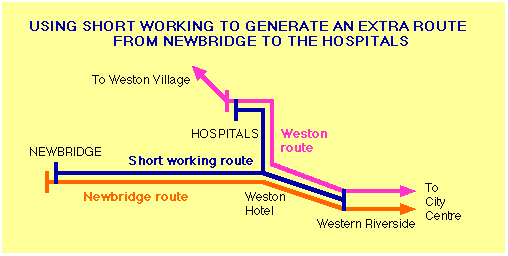
Early trams had a driving position at each end so that they could be driven in either direction. All the controls were duplicated and the vehicle was symmetrical. This gave rise to very few disadvantages and a number of distinct advantages, so the concept of a double-ended tram has remained popular to this day.
NO TURNING CIRCLE
Whereas steerable public transport vehicles need a space in which to turn, so as to begin the return journey with the driver at the front, a tram can proceed in either direction. The driver merely has to walk through the vehicle and take up a driving position at the opposite end from before.
This means that a tram can reverse at any point along its route without special track arrangements. (Although where double track is used, automatic points are provided at intervals to switch the vehicle to the correct track and avoid conflict with other trams).
This allows a system of short working to be devised, which improves the service in the central part of a tramway system whilst reducing unnecessary milage in the less heavily used outer parts.
Short working was used in Bath on the Bathford to Combe Down route. The route was actually made up from two routes which overlapped in the central area. One ran from Bathford to Lambridge, through the City Centre and terminated at the Bear Flat. The other began at Combe Down, ran through Bear Flat and the City Centre and terminated at Lambridge. At Lambridge and Bear Flat, the trams were said to be 'turned short' of their destination (although they were not actually turned at all)

Thus the central heavily-used section from Lambridge to Bear Flat (later Devonshire Buildings) was served by a double-frequency of trams, whereas the outer ends had only the normal single service frequency.
Nowadays, in emergency working, or where the service has become chaotic because of an unforseen incident, the ability to 'short work' and reverse trams to get them back in the correct sequence is a powerful tool for re-establishing an orderly timetable with the minimum of fuss. In Croydon it is one of the factors which is giving the tram service an unrivalled reputation for reliability.
In the current proposals, a type of short working could be used on the Newbridge and Hospitals routes to derive an extra service for the Hospitals, although its apparent benefits might be difficult to justify in practice.
An initial suggestion was that a tram could run from Newbridge to the Weston Hotel or Western Riverside, it could then be turned short and run directly to the Hospitals. This would give a rapid shuttle service from Newbridge to the Hospitals. Although this might be a laudable concept, it would be a very uneconomic use for a tram which could be performing other duties.
As an alternative, certain trams from the Newbridge route could shuttle via the Hospital and then continue with their normal duty. They would need to be clearly identified to avoid causing confusion and frustration to other users who would have been expecting a rapid and direct journey to or from the city centre.

This idea is probably better kept as a reserve plan to be used only in the event of special circumstances which require the rapid transfer of large numbers of people from Newbridge to the Hospitals.
| More about timetables? |
|